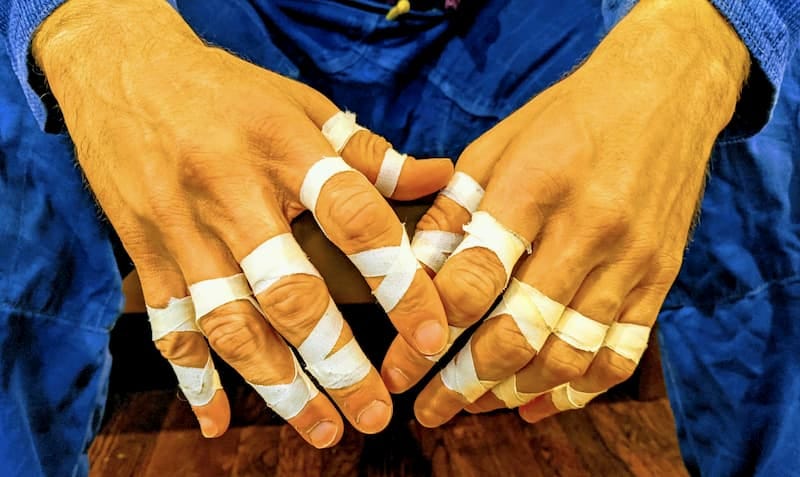How to Train Jiu Jitsu WITHOUT Destroying Your Body(PART 1)
Is this even possible??
Jiu Jitsu is supposedly the ‘gentle’ art.
Bullshit. There’s nothing gentle about it.
Gyms are a graveyard for chronic, irreversible damage to the body:
ACLs shredded off the bone.
Meniscus tears, popping and clicking with every step.
Necks so jacked up from guillotines that turning your head feels like a death sentence.
Fingers so mangled from years of grip fighting that you can’t even make a fist anymore.
But here's the raw truth no one is telling you—it doesn't have to be this way.
"Just focus on technique," they'll tell you.
"Getting injured is just part of the game," they'll say.
"I’ll just take test & TRT like all the best guys in the world,” they’ll rationalise.
What separates those with longevity from those who destroy their bodies along the journey to grappling mastery - is ruthless intelligence.
The choice is yours:
Keep doing what everyone else is doing, and become one of those guys limping around with a herniated disc that never heals... one of those guys with a cranked-up neck that makes sleeping a nightmare... one of those broken, washed-up grapplers forced off the mats by your mid-30s.
OR
Become LETHAL FOR DECADES by mastering what I'm about to show you:
BUILD LONGEVITY ON THE MATS TO DOMINATE WELL INTO YOUR 40s, 50s AND BEYOND
DRASTICALLY MINIMISE CAREER-THREATENING INJURIES BEFORE THEY HAPPEN
PROTECT YOUR BODY WHILE STILL DEVELOPING SAVAGE EFFECTIVENESS ON THE MATS
I am going to condense these key learning take aways into:
6 CLEAR STEPS TO BUILD A JIU JITSU DURABLE PHYSIQUE
Forging a physique built for jiu jitsu requires a specialised approach. The demands of jiu jitsu are incredibly unique & your training needs to reflect this. Being strong is NOT enough, you need to be STRONG & FLEXIBLE.
The easiest way to reverse engineer this process is by looking at the ‘highest risk’ injury area sites found in the sport (source).
These areas are:
Lower Back
Neck
Knees
Shoulders
Elbows & Wrists
Hands & Fingers
Now that we have established these common injury areas, let’s cover the 5 step framework to dramatically reduce injury risk & also build a Jiu Jitsu Durable Physique:
STEP 1 - BUILD LETHAL GENTLEMAN STRENGTH STANDARDS
Your base level of strength will forge strong muscles, tendons, connective tissue & bones. All of which need to be strong & robust to handle the demands of training.
This means that we have objective measurements for the lifts we are aiming for, these are directly from the Lethal Gentleman Standards:
Bench Press: 1.5x Bodyweight
Squat: 2x Bodyweight
Deadlift: 2.5x Bodyweight
Pull Ups: 15-20 reps
If you develop these standards, you have the BASE strength in order to produce force which will also make it easier to manipulate your opponents, but it’s also assumed that with these standards you have advanced levels of muscle tissue, nervous system development & connective tissue to handle jiu jitsu.
STEP 2 - BUILD AN ELITE GAS TANK
Everyone is so strength obsessed, but fatigue makes cowards of us all.
It also:
Reduces skill execution
Decreases decision making
Increases risk of injury in later stage rolling
Makes your slower & makes your body feel ‘heavy’
An elite gas tank, and premium conditioning is arguably MORE important than maximal strength in martial arts (however strength is very important in grappling due to the grinding demands of the sport).
Hard rolling is not enough for conditioning, and the fact that majority of injuries in BJJ occur when rolling, it does not make sense to try to build your cardio is the most ‘risky’ element of training.
For my philosophy on VO2Maxxing, check this article out here.
STEP 3 - GYM TRAIN 2-3x PER WEEK
A common pattern among grapplers is overtraining is the skills department. This might accelerate your progress in the short term, but your body WILL break down if it’s not complimented with training that forges a durable physique.
At the very least, integrating 2x FULL BODY sessions per week which focus on the Lethal Gentleman standards, where you’re progressively overloading and getting stronger on the core lifts is paramount.
If you want to learn the specifics of how to set your weekly training up, check out The Submission Specialist Protocol.
STEP 4 - INJURY ROBUSTNESS CIRCUITS POST TRAINING
To ‘top up’ on your durability training, you can integrate circuits based on the most common areas of injury, let’s cover an example circuit below.
You run these in a circuit fashion, no rest between exercises & complete 2-3 rounds, which will only add another 10 MINUTES to the END of your skills training, whilst drastically minimising injury risk.
Very worthy investment if you ask me.






